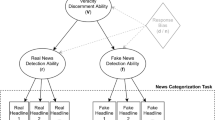Abstract
The impact of response distortion (faking) on selection decisions was investigated. Participants (N = 224) completed the NEO-PI-R under instructions to “make the most favorable impression” and/or “answer honestly.” Those instructed to fake were often over-represented at the top of the score distributions as instructions to fake resulted in higher scores both between and within groups in a test–retest situation. There was significantly lower correspondence between participants’ honest scores and their faked scores as well as multiple instances where participants with unfavorable honest scores subsequently produced the most favorable scores when faking. Response distortion may remain a serious threat to the use of personality test scores in selection.
Similar content being viewed by others
Notes
In the original design of this study a manipulation was introduced, prior to Stage 2 testing, from which half the participants were presented a lecture on the five factor model and the other half were presented a lecture on legal issues in selection. It was hypothesized that information regarding the factors tested with the NEO-PI-R would better enable participants to fake. This hypothesis was not supported. While it was decided the most parsimonious way to present the results of Hypotheses 1A and 1B was to combine these two groups, only those who received the control lecture (on legal issues) were included in the analyses for Hypothesis 2, so groups were more closely equal in treatment and size.
While there is no statistically significant difference, the shift from a 3:1 ratio in favor of Group 1 at time 1 (at the 25% selection rate) to a ratio of less than 1.5:1 at time 2 favors the hypothesis.
References
Barrick M. R., Mount M. K. (1991) The Big Five personality dimensions and job performance: A meta-analysis Personnel Psychology 44: 1–26
Cellar D. F., Miller M. L., Doverspike D., Klawsky J. D. (1996) Comparison of factor structures and criterion-related validity coefficients for two measures based on the five factor model Journal of Applied Psychology 81: 694–704
Costa P. T., McCrae R. R. (1988) Personality in adulthood: A six-year longitudinal study of self-reports and spouse ratings on the NEO Personality Inventory Journal of Personality and Social Psychology 54: 853–863
Costa P. T., McCrae R. R. (1989) The NEO-PI/NEO-FFI manual supplement Psychological Assessment Resources Odessa, FL
Costa P. T., McCrae R. R. (1992) Professional manual for the NEO Personality Inventory Psychological Assessment Resources Odessa, FL
Costa P. T., McCrae R. R., Dye D. A. (1991) Facet scales for agreeableness and conscientiousness: A revision of the NEO personality inventory Personality and Individual Differences 12: 887–898
Donovan J. J., Dwight S. D., Hurtz G. M. (2003) An assessment of the prevalence, severity, and verifiability of entry-level applicant faking using the randomized response technique Human Performance 16: 81–106
Ellingson J. E., Sackett P. R., Hough L. M. (1999) Social desirability corrections in personality measurement: Issues of applicant comparison and construct validity Journal of Applied Psychology 84: 155–166
Frei, R. L., Griffith, R. L., Snell, A. F., McDaniel, M. A., & Douglas, E. F. (1997). Faking of non-cognitive measures: Factor invariance using multiple groups LISREL. Paper presented at the 12th annual meeting of the Society for Industrial and Organizational Psychology, St. Louis, MO
Furnham A. F. (1997) Knowing and faking one’s five-factor personality score Journal of Consulting Psychology 14: 408–413
Hogan R., Hogan J., Roberts B. W. (1996) Personality measurement and employment decisions: Questions and answers American Psychologist 51: 469–477
Hough L. M. (1998) Effects of intentional distortion in personality measurement and evaluation of suggested palliatives Human Performance 11: 209–244
Kurz J.E., Parish C.L. (2001) Semantic response consistency and protocol validity in structured personality assessment: The case of the NEO-PI-R Journal of Personality Assessment 76: 315–332
McCrae R. R., Costa P. T. (1983) Social Desirability scales: Mores substance than style Journal of Consulting and Clinical Psychology 25: 109–115
Mueller-Hanson R., Heggestad E. D., Thornton G. C. III (2003) Faking and selection: Considering the use of personality from select-in and select-out perspectives Journal of Applied Psychology 88: 348–355
Ones D. S., Viswesveran C., Reiss A. D. (1996) Role of social desirability and faking on personality and integrity assessment for personnel selection Human Performance 11: 245–269
Paulhus D. L., Bruce M. N., Trapnell P. D. (1995) Effects of self-presentation strategies on personality profiles and their structure Personality and Social Psychology Bulletin 21: 100–108
Rosse J. G., Stecher M. D., Miller J. L., Levin R. A. (1998) The impact of response distortion on preemployment personality testing and hiring decisions Journal of Applied Psychology 83: 634–644
Schmit M. J., Ryan A. M. (1993) The Big Five in personnel selection: Factor structure in applicant and nonapplicant populations Journal of Applied Psychology 78: 966–974
Schuler H., Thornton G. C. III, Frintrup A., Mueller-Hanson R. (2004) Achievement motivation inventory test manual Hogrefe Goettingen, Germany
Tett R., Jackson D., Rothstein M. (1991) Personality measures as predictors of job performance: A meta-analytic review Personnel Psychology 44: 703–742
Viswesveran C., Ones D. S. (1999) Meta-analyses of fakeability estimates: Implications for personality measurement Educational and Psychological Measurement 59: 197–210
Zickar M. J., Rosse J. G., Levin R. A., Hullin C. L. (1997) Modeling the effects of faking on personality tests Journal of Applied Psychology 84: 551–563
Author information
Authors and Affiliations
Corresponding author
Additional information
Philip Lewis workded on the preparation of this article while a Visiting Professor of Behavioral Sciences and Leadership at the United States Military Academy, West Point, New York.
Rights and permissions
About this article
Cite this article
Winkelspecht, C., Lewis, P. & Thomas, A. Potential Effects of Faking on the NEO-PI-R: Willingness and Ability to Fake Changes Who Gets Hired in Simulated Selection Decisions. J Bus Psychol 21, 243–259 (2006). https://doi.org/10.1007/s10869-006-9027-4
Published:
Issue Date:
DOI: https://doi.org/10.1007/s10869-006-9027-4




